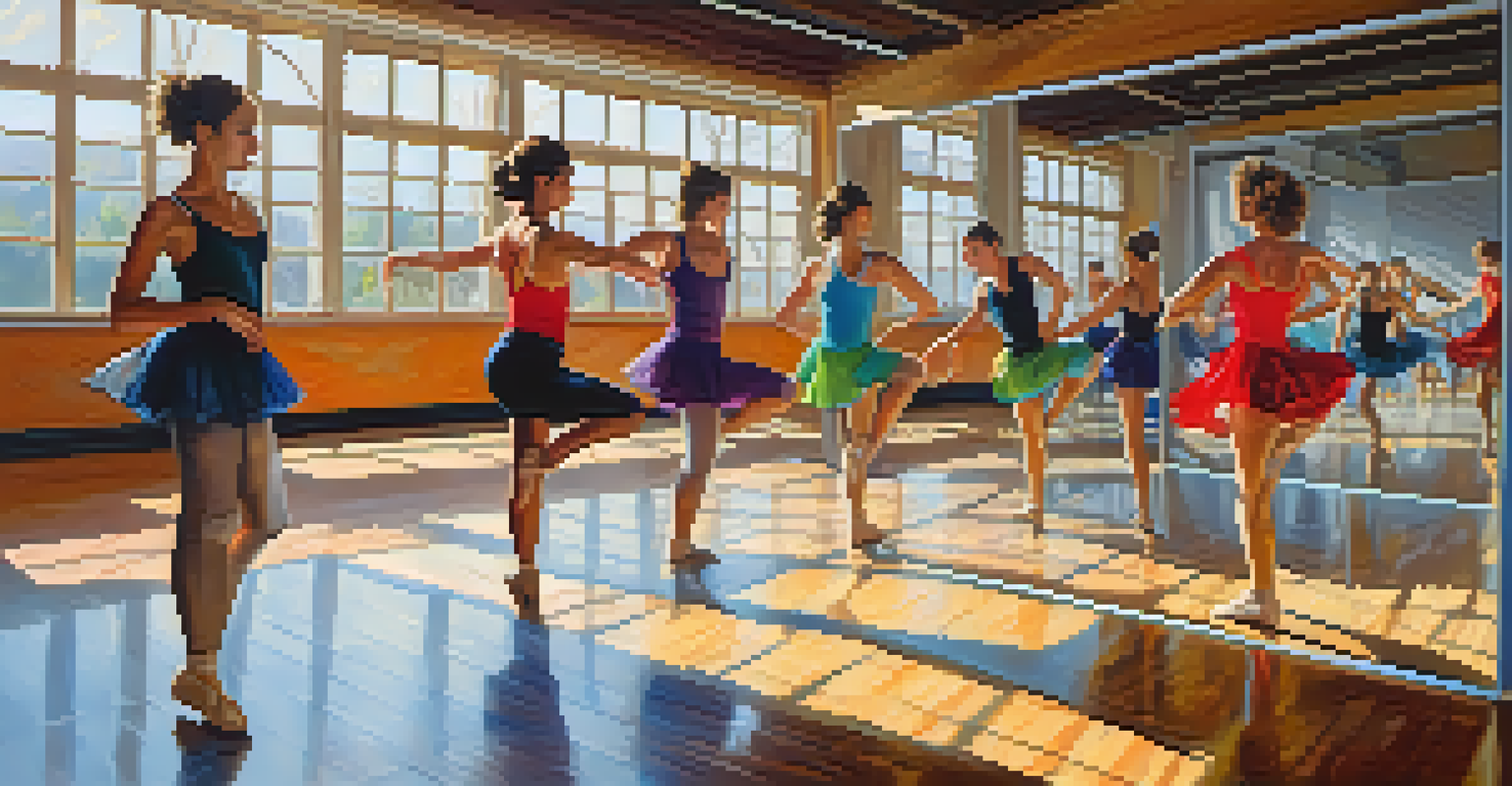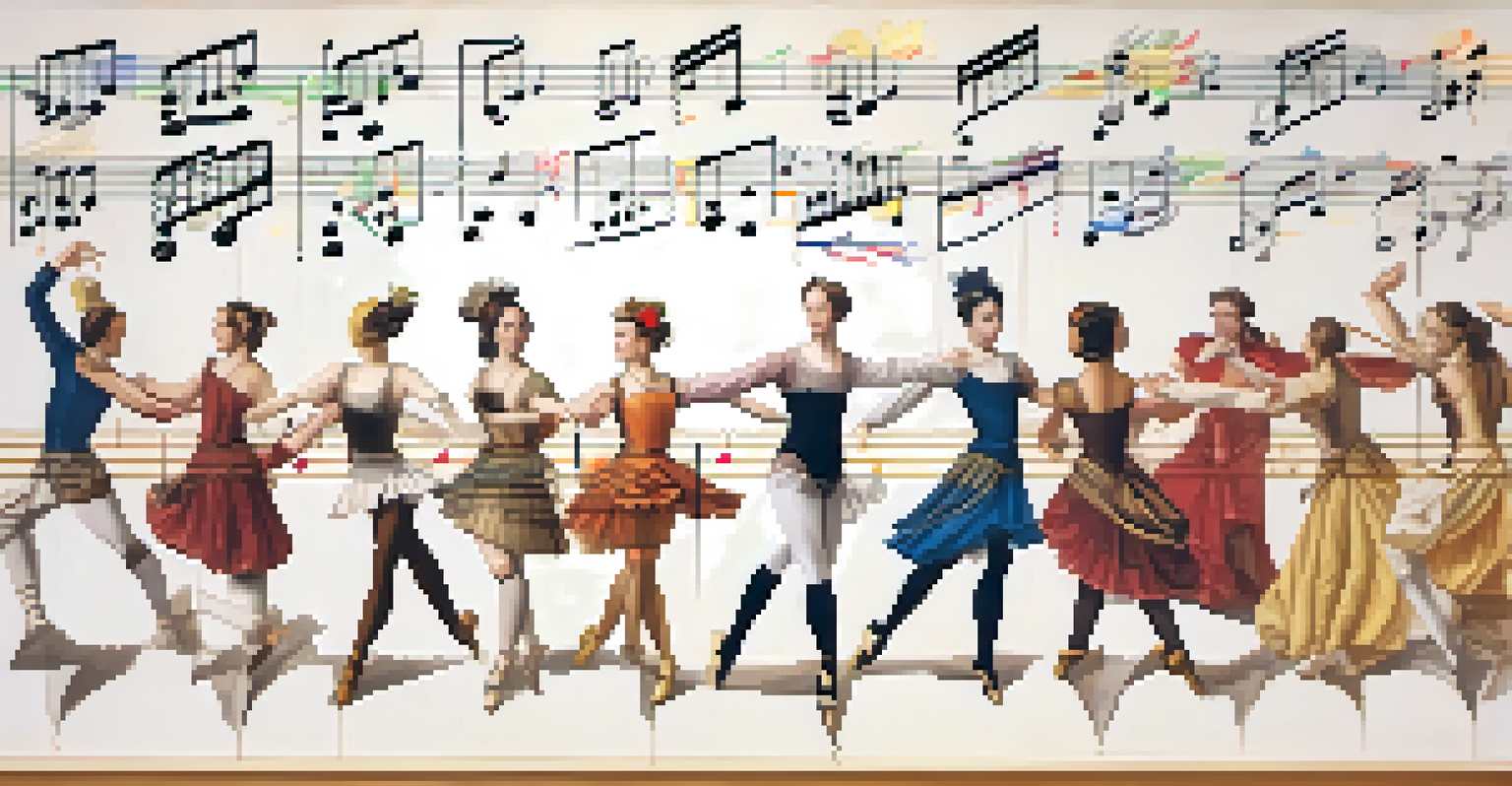The Evolution of Dance Notation: Historical Perspectives

Understanding Dance Notation: What Is It?
Dance notation serves as a written language for documenting dance movements, enabling choreographers to preserve their work. It includes symbols and instructions that guide dancers on how to perform specific routines. Just as musicians rely on sheet music, dancers depend on notation to keep their art alive and accessible.
Dance is the hidden language of the soul.
Historically, dance notation has evolved alongside dance itself, adapting to various styles and forms. In essence, it’s like a map that leads dancers through the creativity of choreography. This written form of dance helps ensure that the energy and emotion of a performance can be passed down through generations.
By understanding dance notation, we can appreciate the complexities involved in choreographing a piece. It opens a window into the creative process, allowing us to see how movements are crafted, structured, and ultimately brought to life on stage.
The Origins of Dance Notation: A Look Back
The earliest forms of dance notation can be traced back to the Renaissance period, where dance manuals began to emerge. These manuals often included rudimentary symbols to represent movements, similar to early attempts at musical notation. It was a time when dance was becoming a formalized art, and the need for documentation grew.

One of the notable figures in this early development was Thoinot Arbeau, whose book 'Orchésographie' outlined various dance steps for social dances of the time. This work marked a significant shift, as it combined practical instruction with artistic expression, paving the way for future notation systems. Essentially, it was the foundation upon which modern dance notation would eventually be built.
Dance Notation Preserves Creativity
Dance notation serves as a vital tool for documenting and preserving choreographic works, ensuring that the art form can be passed down through generations.
As dance spread across Europe, different regions began to develop their own notation systems, each reflecting local styles and traditions. This diversity highlighted the rich tapestry of dance and began to show how notation could adapt to different cultural contexts.
18th Century Innovations: The Rise of More Formal Systems
The 18th century saw the emergence of more sophisticated dance notation systems, particularly with the work of figures like Raoul Auger Feuillet. His system, known as 'Feuillet Notation,' introduced a set of symbols that represented movements and positions in a detailed manner. This was a game-changer, as it allowed for greater precision in documenting choreography.
The dance is a poem of which each movement is a word.
Feuillet's notation was primarily designed for ballroom dance, reflecting the social nature of dance during this period. The popularity of this system underscored the growing importance of dance as a cultural phenomenon. It was as if dance was finally getting the attention it deserved in the world of literature and art.
This era marked a significant advancement in the formalization of dance notation, setting the stage for future developments. It demonstrated that dance could be analyzed and taught with the same rigor as other art forms, which was a revolutionary idea at the time.
The 19th Century: Expanding Notation for New Styles
As the 19th century rolled in, so did new dance styles and a need for notation systems that could keep pace. The emergence of ballet as a dominant form of dance led to the creation of the 'Kinetography' or 'Labanotation' system by Rudolf Laban. This notation allowed for a more comprehensive recording of dance movements, including dynamics and spatial aspects.
Labanotation was groundbreaking as it provided a visual representation of movement, which was crucial for dancers, choreographers, and educators. The ability to capture the nuances of dance in a structured format made it easier to teach and learn complex routines. This transition mirrored the broader changes in society, which was becoming more focused on formal education and the arts.
Historical Evolution of Notation
Dance notation has evolved significantly from rudimentary symbols in the Renaissance to sophisticated digital tools, reflecting the changing landscape of dance styles and education.
During this time, various other systems also emerged, reflecting the diversity of dance practices. Each notation system had its unique strengths, catering to different styles and teaching methods. This proliferation of notation systems highlighted the adaptability of dance as an art form.
Modern Dance Notation: Digital Age and New Tools
In the 20th century, the landscape of dance notation transformed once again with the advent of technology. Digital tools began to emerge, allowing choreographers to create dance notation using software instead of traditional pen and paper. This shift made the process more efficient and accessible, bringing dance notation into the digital age.
Software programs have simplified the task of documenting choreography, enabling dancers and educators to share their work globally. This development not only preserves dance but also encourages collaboration and innovation across different styles and cultures. In a sense, it has democratized dance, making it easier for anyone to engage with this expressive art form.
Modern dance notation also embraces multimedia elements, integrating video and audio to enhance the instructional experience. This evolution reflects broader trends in education and communication, where visual and auditory learning plays a significant role. As a result, dance notation has become more dynamic and engaging, reflecting the vibrant nature of dance itself.
Challenges and Critiques of Dance Notation
Despite its advancements, dance notation is not without its challenges. Critics argue that no system can fully capture the essence of a live performance, including the emotion and spontaneity that dancers bring to the stage. It's akin to trying to convey the taste of a dish through a recipe—some elements simply can't be captured in words or symbols.
Moreover, the complexity of certain dance styles can make notation cumbersome and difficult to understand. For example, improvisational dance often defies strict notation rules, leading to a disconnect between written instructions and actual performance. This has led some in the dance community to question the value of notation in capturing the fluidity of movement.
Challenges in Capturing Performance
Despite its usefulness, dance notation faces challenges in fully capturing the spontaneity and emotion of live performances, sparking debate within the dance community about its limitations.
Despite these critiques, many still view dance notation as an invaluable tool for preservation and education. It serves as a bridge between creativity and structure, helping to ensure that dance continues to thrive across generations. Ultimately, the challenges of dance notation highlight the ongoing dialogue about the relationship between art and its documentation.
The Future of Dance Notation: What's Next?
Looking ahead, the future of dance notation seems to be on the brink of further evolution. As technology continues to advance, we may see the development of even more sophisticated systems that incorporate virtual and augmented reality. This could revolutionize how dancers learn and perform, providing immersive experiences that blend physical movement with digital innovation.
Additionally, the growing interest in interdisciplinary art forms may encourage the creation of hybrid notation systems that can accommodate diverse styles and practices. This could lead to a more unified approach to dance documentation, fostering collaboration between different genres and cultures. The idea is to create a common language that reflects the richness of dance as a global art form.

Ultimately, the future of dance notation lies in its ability to adapt and respond to the needs of artists and educators. As we continue to explore the intersections of technology, culture, and creativity, dance notation will remain a vital part of preserving and sharing this beautiful art form for generations to come.